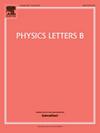霍金-佩奇方法中旋转等离子体的全息QCD相位图
IF 4.5
2区 物理与天体物理
Q1 ASTRONOMY & ASTROPHYSICS
引用次数: 0
摘要
我们研究了旋转和有限化学势在强相互作用物质的约束/去约束跃迁中的联合效应。全息描述由一个五维几何图形组成,其中包含一个处于定义(等离子体)相位的黑洞(BH)。几何结构配备了一些截止,引入了红外能量刻度。我们考虑了两种可能性:所谓的硬壁和软壁AdS/QCD模型。等离子体相和强子相之间的跃迁被全息地表示为有黑洞和没有黑洞的几何形状之间的霍金-佩奇跃迁。在有限密度下旋转等离子体的引力对偶由一个具有非零角动量的Reissner-Nordström (RN)带电反德西特(AdS)黑洞给出。这种分析提供了作为夸克化学势和等离子体旋转速度函数的解离临界温度。在极低温的情况下,发现了T→0发生转变的化学势的临界值与旋转的关系。本文章由计算机程序翻译,如有差异,请以英文原文为准。
Holographic QCD phase diagram for a rotating plasma in the Hawking-Page approach
We investigate the combined effect of rotation and finite chemical potential in the confinement/deconfinement transition of strongly interacting matter. The holographic description consists of a five-dimensional geometry that contains a black hole (BH) in the deconfined (plasma) phase. The geometry is equipped with some cut-off that introduces an infrared energy scale. We consider two possibilities: the so-called hard wall and soft wall AdS/QCD models. The transition between the plasma and hadronic phases is represented holographically as a Hawking-Page transition between geometries with and without a black hole. The gravitational dual of the rotating plasma at finite density is given by a Reissner-Nordström (RN) charged anti-de Sitter (AdS) BH with non-zero angular momentum. This analysis provides the critical temperature of deconfinement as a function of the quark chemical potential and the plasma rotational velocity. For the case of very low temperatures, the dependence of the critical values of the chemical potential for the transition to occur at on the rotation is found.
求助全文
通过发布文献求助,成功后即可免费获取论文全文。
去求助
来源期刊

Physics Letters B
物理-物理:综合
CiteScore
9.10
自引率
6.80%
发文量
647
审稿时长
3 months
期刊介绍:
Physics Letters B ensures the rapid publication of important new results in particle physics, nuclear physics and cosmology. Specialized editors are responsible for contributions in experimental nuclear physics, theoretical nuclear physics, experimental high-energy physics, theoretical high-energy physics, and astrophysics.
 求助内容:
求助内容: 应助结果提醒方式:
应助结果提醒方式:


